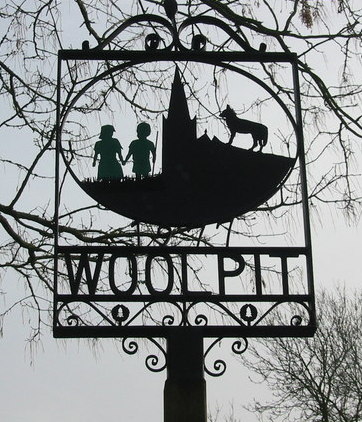England has a long and rich history of folklore that includes countless enchanting tales of strange events, otherworldly creatures, people with supernatural powers, and unknown forces. These tales have accumulated over centuries and created a unique compendium of oddities. Many of the motives that are present in English folklore, like the will-o’-the-wisp, are grounded in people’s wish to explain various unusual phenomena they encounter in their surroundings. Will-o’-the-wisp, a ghostly light that lures night travelers from safe paths, was most likely an attempt to explain faint flickering light that sometimes occurs in the marshlands, a natural phenomenon produced by decaying organic matter.
The earliest written accounts of the tale of the Green Children of Woolpit date back to the writings of William of Newburgh and Ralph of Coggeshall in the late 12th century. While many contemporary historians and ethnologists consider the strange tale to be a product of the rich imagination of English common folk, some claim that the tale was inspired by actual historical events.

According to the tale, farmers from the village of Woolpit in the county of Suffolk dug ditches around the village to trap wolves that frequently attacked the local livestock. One morning, as they headed out toward the fields, the villagers found two children trapped in one of the deeper ditches. To the villagers’ surprise, the children’s skin was bright green and their clothes were made from unfamiliar materials. The children were taken to the village and were then adopted by a wealthy local landowner named Sir Richard de Calne. For several months, they refused to eat anything except raw peas. The boy fell sick and died about half a year after the children were found, but the girl completely adapted to the villagers’ lifestyle and diet.
Her skin color turned normal and she continued living in Woolpit. She eventually married a man from the nearby village of King’s Lynn. As soon as the girl learned to speak English, she told the villagers that she and the boy came from the Land of Saint Martin, an underground community of green-skinned people who never venture out into the sunlight. She also said that the boy was her brother and that they found themselves in the ditch near Woolpit after they got lost in an unfamiliar cave while herding cattle.
The story seems far too ethereal to be true, but some contemporary historians claim that it could be grounded in facts. Namely, the green children might simply have been the children of Flemish immigrants who wandered away from their settlement. In the early 12th century, many migrants arrived in eastern England from Flanders. After 1154, when Henry II became king, they were persecuted by the English and many of them were killed in the area surrounding Woolpit. It is possible that the children’s parents were killed in one of the cruel raids that Henry II organized to clear the area of the Flemish, and that they spent some time in the wilderness before finally reaching the outskirts of Woolpit.
One fact that supports this theory is the existence of a village named Fornham St. Martin, which is situated to the north of Woolpit. This could explain why the girl claimed that they arrived from the “Land of Saint Martin.” Also, they probably spent most of their time in basements and damp makeshift houses where their parents frequently hid them in fear of the king’s soldiers. Finally, the harsh conditions of their childhood and the poverty of their immigrant community could explain their green skin tone: poor diet could have caused them to suffer from Hypochromic Anemia, a condition caused by continuous ingestion of unhealthy and nutrient-poor food which can cause the skin to turn slightly green. The fact that the girl regained healthy skin tone after acquiring a taste for regular food supports this possibility.
Like the origin of most folktales, the source of the tale of the Green Children of Woolpit will likely remain unknown forever. However, due to the historic background of the tale, it is quite possible that the children were unfortunate souls who fled their home to escape certain death and, after spending weeks in the darkness of vast local woodlands, ended up in the ditch outside Woolpit.
